36 BIRDS WITH ORANGE BELLY: Types and Pictures
Orange belly bird
The birds with orange bellies are among the most distinctive. Specific to many species worldwide is a brilliant underside. When it comes to sporting a vivid or dark orange belly, men typically have the upper hand. On their bellies, some male birds even exhibit hints of both brilliant and dark orange. Rarely,
females may additionally have an orange abdomen. Nonetheless, compared to their male counterparts with orange bellies, females are typically duller in color. These birds can survive in a broad range of environments, including tropical and subtropical regions in the Americas and coniferous forests in
Northern Canada.A large number of these birds migrate or migrate in part. Even though their orange bellies—which typically measure up to 10 inches—these birds are capable of flying thousands of miles in search of food. There is a significant proportion of orange-bellied birds in the United States. They either
spend all year round or just a little amount of time here. They are especially prevalent in the Great Basin and the Rocky Mountains. A lot of birds favor Central America because of its arid and even tropical and subtropical temperatures, yet they could stray from there.
It can be difficult to distinguish between birds that have orange bellies and chests in the wild since they are so prevalent. Birds can be challenging to identify on the spot because to their swift and sometimes unpredictable temperament, particularly when several of them have similar distinguishing traits.
1 Barn Swallow
The most common species of swallow worldwide is the barn swallow (Hirundo rustica). Of all the passerines in the world, its natural distribution seems to be the biggest, spanning about 251 million square kilometers worldwide. It is simply referred to as the swallow in Anglophone Europe; in northern Europe, it is the only species that is often termed a “swallow” as opposed to a “martin“.
| Attribute | Information |
|---|---|
| Scientific Name | Hirundo rustica |
| Subspecies with Orange Belly | 3 out of 6 |
| Description | Small bird with bright orange belly and face, blue body and head |
| Distribution Area | North America, South America, Europe, Africa, Asia, Oceania |
| Habitat | Wide open areas, nests in manmade structures, near woodlands |
| Migration | Some migrate to southern hemisphere |

2 American Robin
A migratory member of the larger thrush family, Turdidae, including the genus Truethrush is the American robin (Turdus migratorius). With its pale gray-brown underparts, the San Lucas robin (T. m. confinis) of Baja California Sur is the only one of its seven subspecies that stands out.
| Attribute | Information |
|---|---|
| Scientific Name | Turdus migratorius |
| Common Name | American Robin |
| Description | Common bird in North America with orange belly. Males have vivid orange bellies and black heads. Females are similar but may have duller coloring. |
| Migration | Migrates for overwintering, moving South from Northern territories during winter. |
| Habitat | Woodlands, swamps; active both day and night. |
| Diet | Balanced diet: insects, invertebrates, forest fruits. |
| Distribution Area | Alaska, Canada, United States, Mexico. |
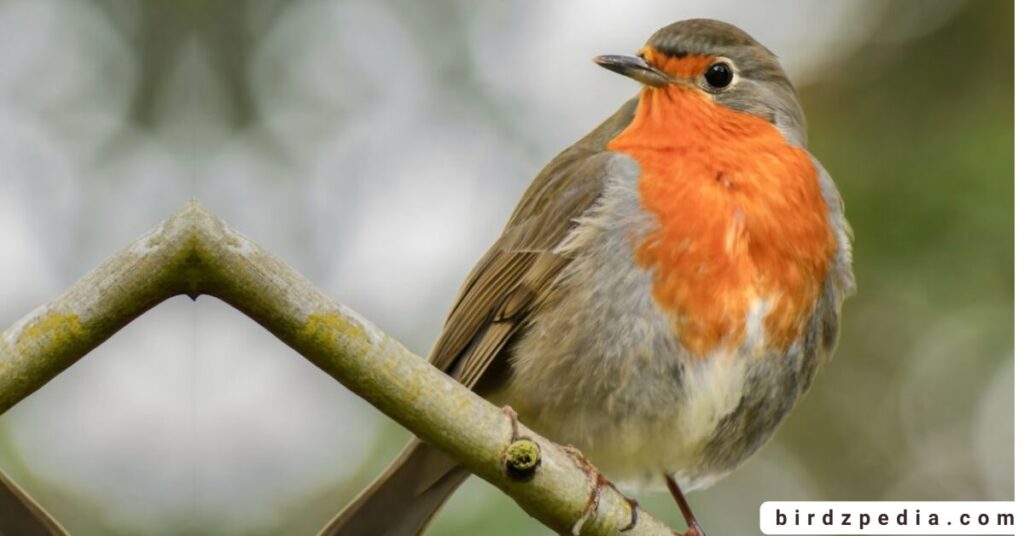
3 Baltimore Orileo
The male Baltimore oriole (Icterus galbula), a little icterid blackbird, got its name because his colors resembled those on Lord Baltimore’s coat of arms from the 17th century.
| Attribute | Information |
|---|---|
| Scientific Name | Icterus galbula |
| Common Name | Baltimore Oriole |
| Description | North and Central American species with orange belly. Males have bright orange bellies and chests, black wings, and heads. Females may have brighter orange or yellow-orange bellies, some with white bellies and yellow chests and heads. |
| Song | Whistling sound |
| Migration | Long-distance migration to Central America for overwintering. |
| Distribution Area | Eastern and Southern Canada, Northeastern United States, Mexico, Costa Rica, Guatemala, Panama, Colombia, Cuba, Jamaica. |
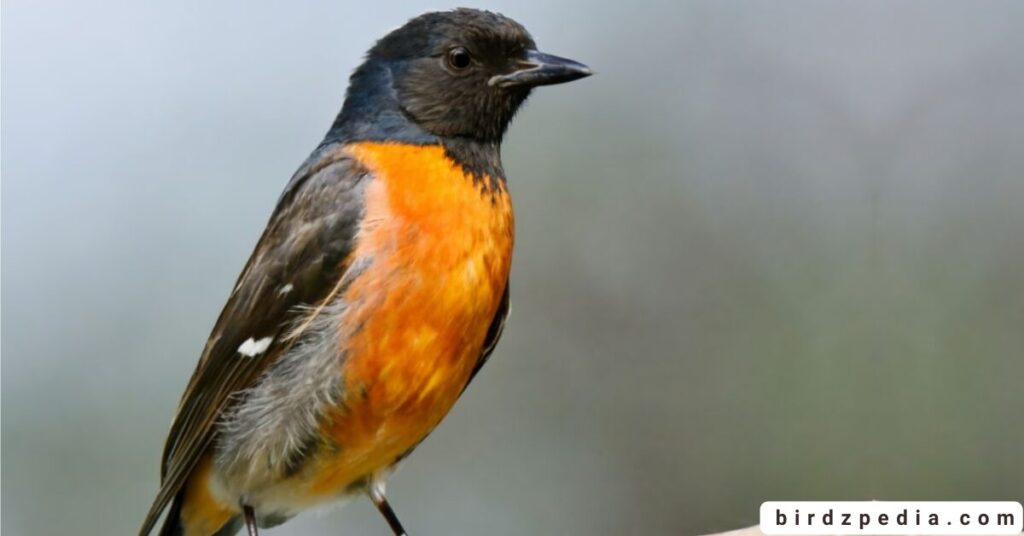
4 Painted Bunting
A species of bird in the Cardinalidae family is the painted bunting (Passerina ciris).Only in their second year of life does the male develop brilliant plumage; in the first, they can only be differentiated from the female by careful examination.
| Attribute | Information |
|---|---|
| Scientific Name | Passerina ciris |
| Common Name | Painted Bunting |
| Description (Male) | Multicolored bird with bright orange belly, blue head and neck, green or yellow-green wings, red and gray. |
| Description (Female) | Bright green or yellow appearance, no orange belly. |
| Subspecies | 2 subspecies in central and Southern areas of the United States. |
| Migration | Migrates to almost all continental states of Central America for overwintering. |
| Diet | Wide range of seeds and grasses. |
| Distribution Area | Florida, Georgia, Louisiana, Texas, Arkansas, Mexico, Guatemala, Costa Rica, Cuba, Haiti. |

5 Black-Headed Grosbeak
The medium-sized, seed-eating black-headed grosbeak (Pheucticus melanocephalus) belongs to the Cardinalidae family of birds.The black-headed grosbeak is a migratory bird with breeding grounds that is 19 cm (7.5 in) long and 47 g (1.7 oz). It hybridizes on the American Great Plains with the rose-breasted grosbeak (P. ludovicianus), with which it is occasionally regarded as conspecific.
| Attribute | Information |
|---|---|
| Scientific Name | Pheucticus melanocephalus |
| Common Name | Black-headed Grosbeak |
| Description (Male) | Black-headed with tan to orange gradient belly, black wings and head. |
| Description (Female) | Lacks orange belly, may have yellow belly instead. |
| Habitat | Dense and tall woodlands, including coniferous woodlands, riparian areas with tall shrubs and trees. |
| Migration | May migrate depending on location; some populations in tropical climates do not migrate. |
| Distribution Area | East and West of The Rocky Mountains, Mexico, Baja California. |
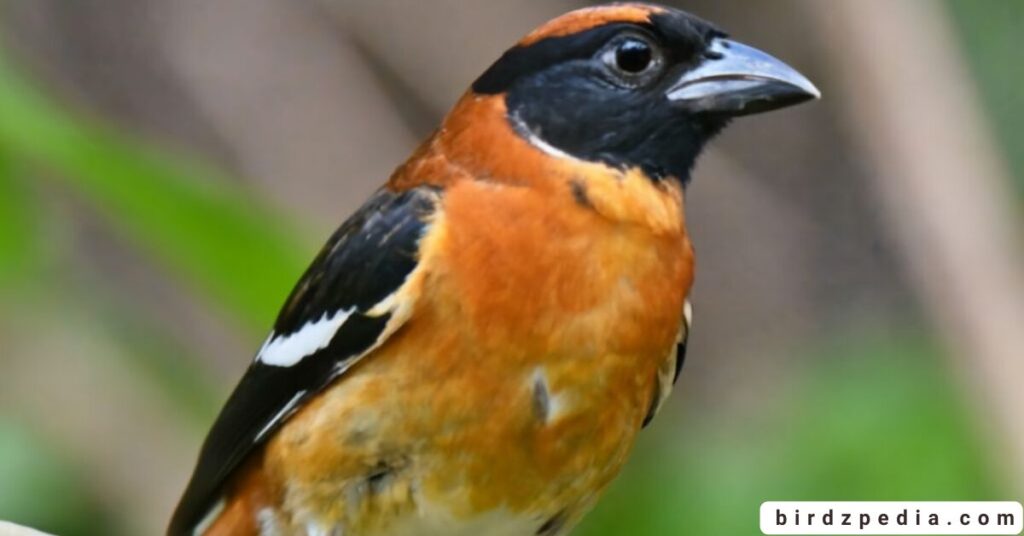
6 Orchard Oriole
The smallest icterid species is the orchard oriole (Icterus spurius). Orchard orioles nest in tightly woven pouches connected to horizontal tree branches, and they prefer to live close to lakes and streams. The name “spurius” for the species comes from their initial erroneous identity as female Baltimore orioles; they are occasionally confused with New World warblers.
| Attribute | Information |
|---|---|
| Scientific Name | Icterus spurius |
| Common Name | Orchard Oriole |
| Description (Male) | Orange belly and upper chest. |
| Description (Female) | Yellow-green color. |
| Habitat | Common in gardens, spends most of its life in trees. |
| Diet | Insects during breeding season, fruits outside breeding season. |
| Size | Between 5 and 7 inches. |
| Altitude | Flies at high altitudes, rarely above tree line. |
| Migration | Migrates South for overwintering. |
| Distribution Area | Eastern US, Mexico, Guatemala, Costa Rica, Panama. |
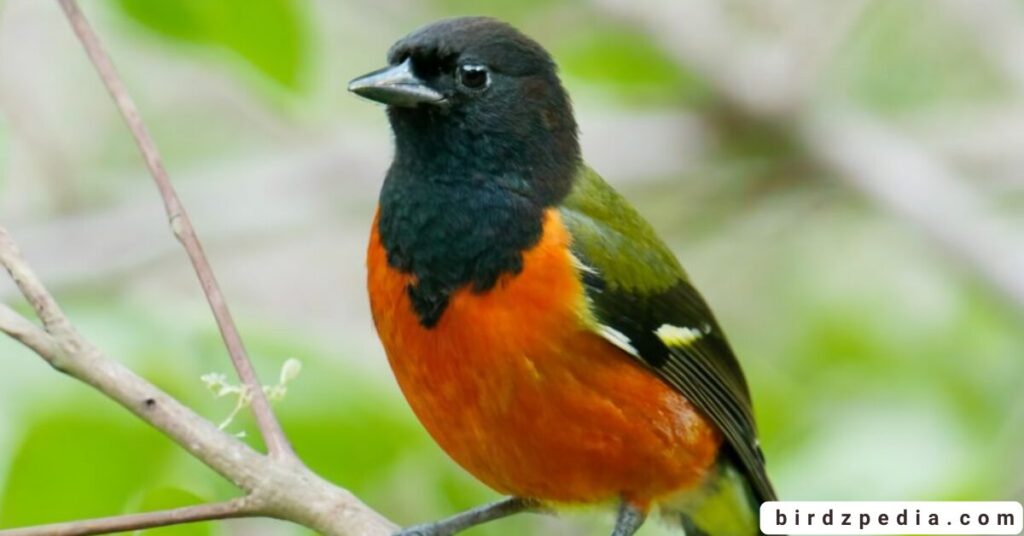
7 Hooded Oriole
Icterus cucullatus, the hooded oriole, is a medium-sized New World oriole. The male of this species has two white bars on each wing and a black back, face, tail, and bib. His color ranges from vivid orange to a softer yellow. The female has touches of yellow, but her overall hue is more olive.
| Attribute | Information |
|---|---|
| Scientific Name | Icterus cucullatus |
| Common Name | Hooded Oriole |
| Description (Male) | Orange-yellow belly and head, dark gray and white wings. |
| Description (Female) | Yellow belly, yellow-green or olive head. |
| Habitat | Central America, Southern parts of The United States. |
| Diet | Plant nectar, fruits, seeds. Can hang upside down for feeding on nectar. |
| Breeding Range | North America |
| Overwintering Range | Central America |
| Distribution Area | Southern US, Southwestern US, Mexico. |
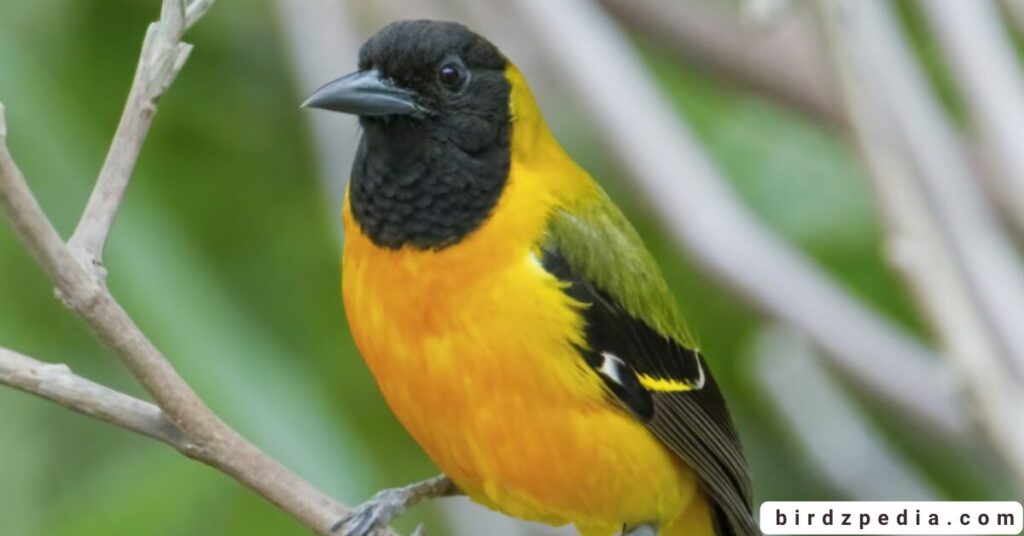
8 Bullock’s Oriole
Small blackbirds of the New World are called Bullock’s orioles (Icterus bullockii). This species and the Baltimore oriole were once thought to be members of the same species, the northern oriole. The English amateur naturalist William Bullock is honored by the name of this bird.
| Attribute | Information |
|---|---|
| Scientific Name | Icterus bullockii |
| Common Name | Bullock’s Oriole |
| Description (Male) | Orange belly, head, body, and wings; black head and body. |
| Description (Female) | White belly, bright yellow head, gray wings. |
| Habitat | Trees and shrubs. |
| Range | Southern British Columbia to Central America. |
| Diet | Fruits, seeds, plant nectar. |
| Distribution Area | Eastern US (breeding range), Central America (overwintering range). |
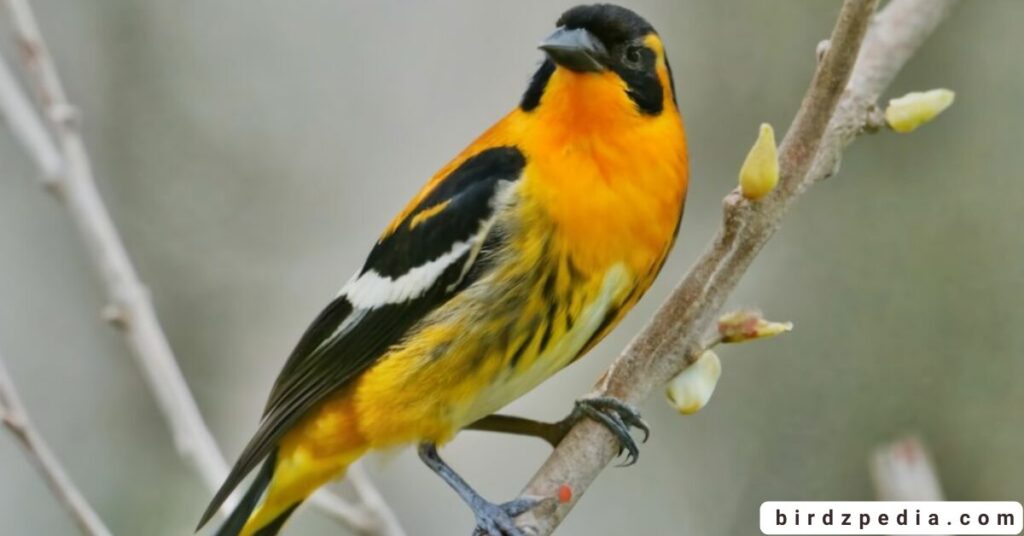
9 Red Knot
Calidris canutus, also known as the red knot or simply knot, is a medium-sized shorebird. Recognized subspecies number six.Seasonal variations in their diet include the preference for arthropods and larvae at breeding grounds and a variety of hard-shelled molluscs at other feeding places.
| Attribute | Information |
|---|---|
| Scientific Name | Calidris canutus |
| Common Name | Red Knot |
| Description | Varying belly coloring (orange, brown, red, or cinnamon), brown, tan, black, and white mottled coloring on the rest of the body. |
| Habitat | Arctic habitat, close to The Arctic Circle. |
| Migration | Extensive migration to Southernmost regions of South America or Southern regions of Australia. |
| Ideal Spotting Areas | Coastal areas, often gathering in large flocks. |
| Distribution Area | Northern Canada territories, Iceland, Greenland, Northern Russia, Argentina, Australia. |
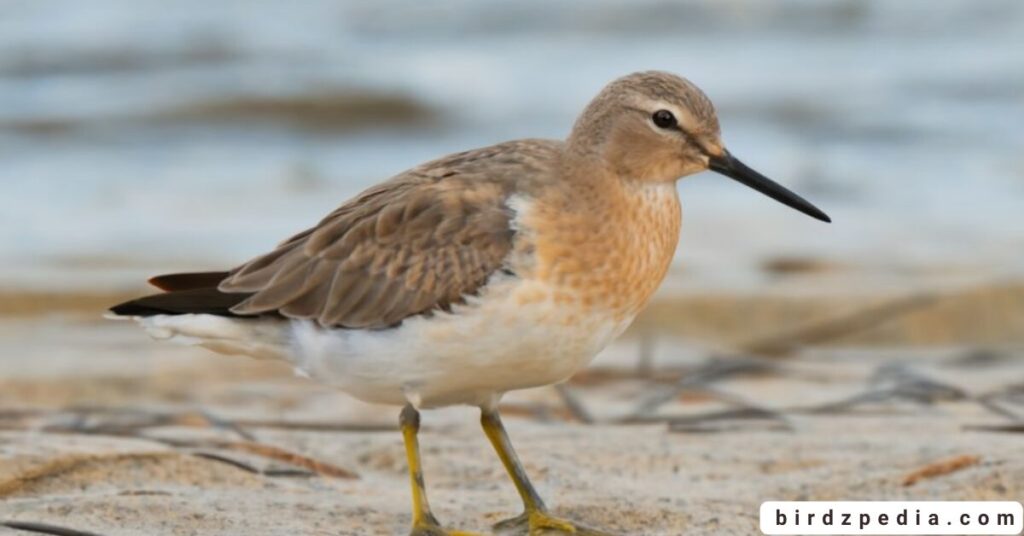
10 Red Crossbill
Within the Fringillidae family of finches, the red crossbill, sometimes known as the common crossbill (Loxia curvirostra), is a tiny passerine bird. Because of their unique mandibles, which are crossed at the tips, crossbills are able to remove seeds from other fruits and conifer cones.
| Attribute | Information |
|---|---|
| Scientific Name | Loxia curvirostra |
| Common Name | Red Crossbill |
| Description (Male) | Orange bellies and heads; males may also have red main coloring. |
| Description (Female) | Brighter, closer to yellow. |
| Beak | Crossed beak adapted for extracting seeds from cones. |
| Habitat | Woodlands with sufficient cones as food. |
| Distribution | Worldwide distribution across coniferous woodlands. |
| Migration | Migratory; influenced by food availability. |
| Distribution Area | Alaska, Canada, United States, Mexico. |

11 White-Rumped Shama
The Muscicapidae family comprises the little passerine bird known as the white-rumped shama (Copsychus malabaricus). It was once referred to as the white-rumped shama thrush or just shama thrush because it belonged to the Turdidae family of thrushes.
| Attribute | Information |
|---|---|
| Scientific Name | Copsychus malabaricus |
| Common Name | White-rumped Shama |
| Description (Male) | Partially orange belly, black chest, black head and wings. |
| Description (Female) | Brighter orange belly, black head and wings. |
| Wing Length | Long black wings longer than body. |
| Habitat | Mostly found in bamboo woodlands. |
| Cage Bird | Sought-after cage birds, escaped and established populations outside native range. |
| Aggression | Males aggressive during breeding, establish territories. |
| Distribution Area | Asia, Hawaii. |
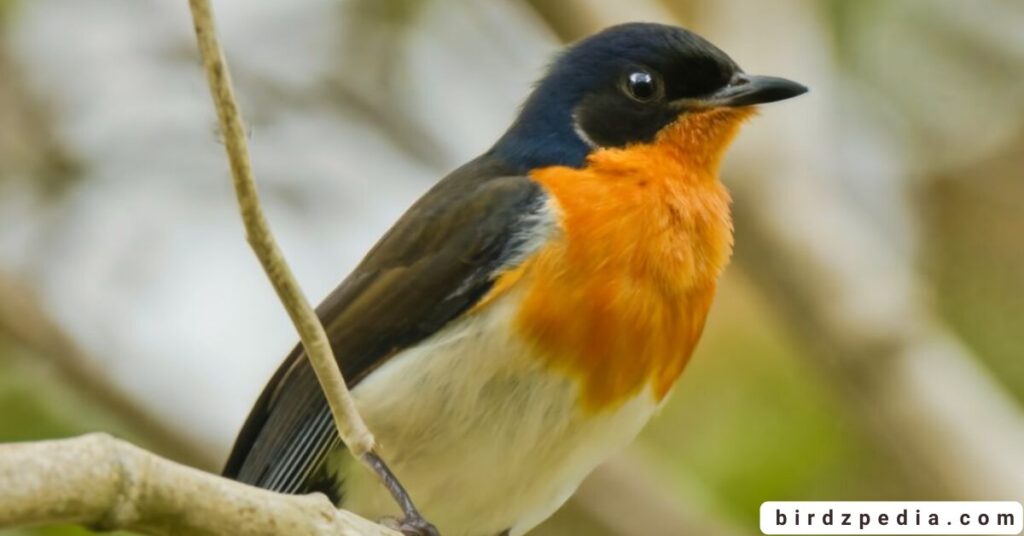
12 Altamira Oriole
One of the New World orioles is the Altamira oriole (Icterus gularis). In the genus Icterus, this is the largest oriole at 25 cm (9.8 in) and 56 g (2.0 oz). The bird builds its nests in open forests. The nest is a very long woven pouch that is occasionally fastened to telephone wires
and the end of a horizontal tree branch. This bird feeds on the tops of trees and occasionally in the underbrush. They primarily consume berries and insects.
| Attribute | Information |
|---|---|
| Scientific Name | Icterus gularis |
| Common Name | Altamira Oriole |
| Description (Male) | Vivid orange belly and head, black wings and mask. |
| Description (Female) | Yellow with black face mask. |
| Migration | Non-migratory |
| Habitat | Arid regions of Central America, absent from tropical woodlands. |
| Diet | Forages for seeds and fruit. |
| Presence | Year-round presence, solitary. |
| Distribution Area | Mexico, Guatemala, Panama. |
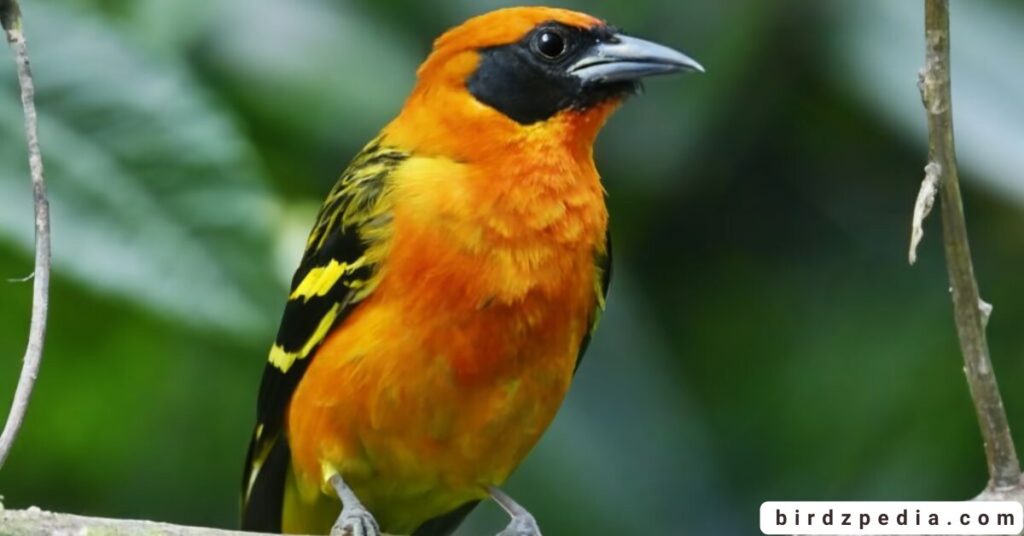
13 Spot-Breasted Oriole
One species of bird in the Icteridae family is the spot-breasted oriole (Icterus pectoralis). Adults range in length from 21 to 24 cm (8.3 to 9.4 in). On average, males weigh approximately 50 g (1.8 oz), and females weigh 45 g (1.6 oz).
The measurements of the culmen are 1.9–2.4 cm (0.75–0.94 in), the tarsus is 2.6–3 cm (1.0–1.2 in), the wing bone is 8.8–11.4 cm (3.5–4.5 in), and the tail is 8.5–11.2 cm (3.3–4.4 in).
| Attribute | Information |
|---|---|
| Scientific Name | Icterus pectoralis |
| Common Name | Spot-breasted Oriole |
| Description (Male) | Orange belly and head with black mask and upper chest. |
| Description (Female) | Brighter, dominated by olive shades instead of orange. |
| Habitat | Tropical climates, both humid and dry conditions, woodlands and dry areas. |
| Distribution | Mexico, Guatemala, Honduras, Nicaragua, Florida. |
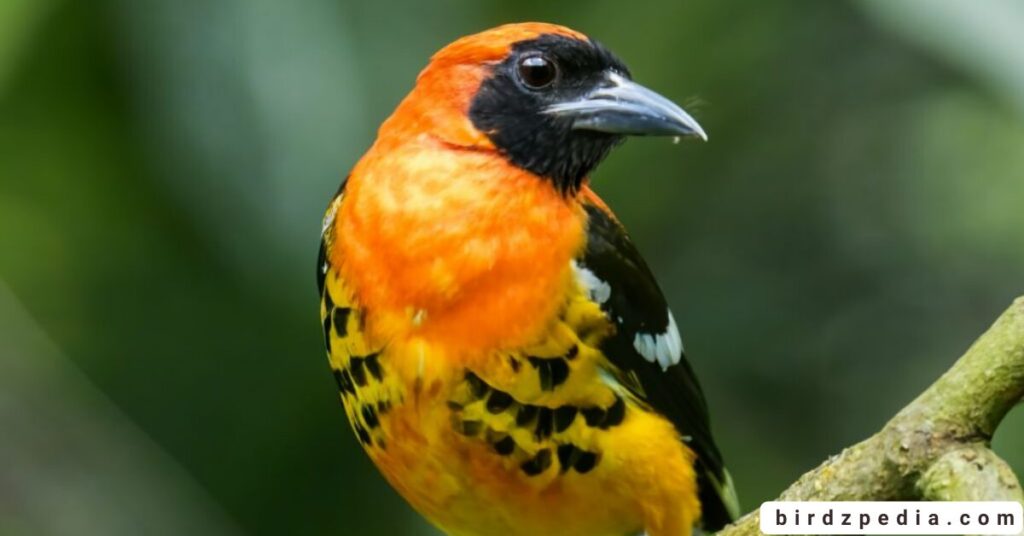
14 Elegant Trogon
Within the trogon family, the elegant trogon (Trogon elegans), formerly known as the coppery-tailed trogon, is a near passerine bird.The word “trogon” has its etymology from the Greek word “trōgein,” which means “to gnaw“.
This term depicts the process by which this species creates its nests in trees.With a length of 28–30 centimeters (11–12 in) and a weight of 60–78 grams (2.1–2.8 oz) (average 68 grams (2.4 oz), this species is a medium-sized bird.
| Attribute | Information |
|---|---|
| Scientific Name | Trogon elegans |
| Common Name | Elegant Trogon |
| Description (Male) | Red belly, black and white chest, black head, gray wings. |
| Description (Female) | Orange belly, gray body and head, gray and white chest. |
| Habitat | Pineoak woodlands, elevations up to a few thousand feet. |
| Distribution | Southern US, Mexico. |
| Status | Endangered in some Southern US territories. |
| Behavior | Distinctive call, easily spotted together during breeding. |
| Breeding | Females seek existing cavities to lay eggs after breeding. |

15 Hawaii Akepa
Native to Hawaiʻi in the Hawaiian Islands, the Hawaiʻi żakepa (Loxops coccineus) is an endangered species.It’s a dusty green bird about four inches (10 cm) long. Men are a vivid orange color. It shares the same small cross bill as other Loxops species. It makes a lengthy, trilling sound at the end of its soft, quivering whistle call.
| Attribute | Information |
|---|---|
| Scientific Name | Loxops coccineus |
| Common Name | Hawaii Akepa |
| Description (Male) | Bright orange belly and head. |
| Habitat | Hawaii, specific conditions required for survival. |
| Diet | Nectar of few plant species, insects, spiders. |
| Nesting Habits | Requires cavities in old trees at high elevations. |
| Climate Change Impact | Among the first birds affected by climate change. |
| Distribution Area | Hawaii. |
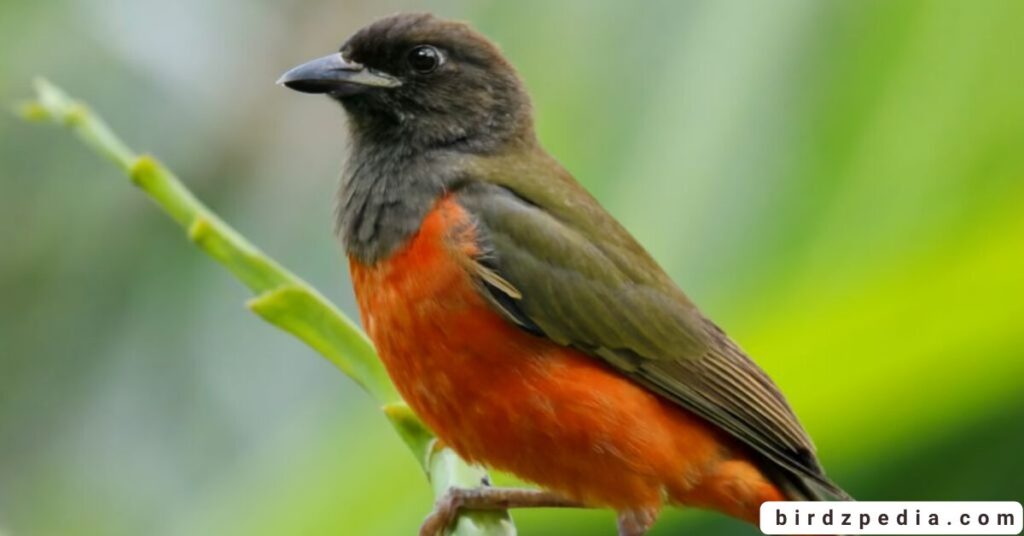
16 Daurian Redstart
Native to Hawaiʻi in the Hawaiian Islands, the Hawaiʻi żakepa (Loxops coccineus) is an endangered species.It’s a dusty green bird about four inches (10 cm) long. Men are a vivid orange color. It shares the same small cross bill as other Loxops species. It makes a lengthy, trilling sound at the end of its soft, quivering whistle call.
| Attribute | Information |
|---|---|
| Scientific Name | Phoenicurus auroreus |
| Common Name | Daurian Redstart |
| Description (Male) | Multicolored appearance with orange to yellow belly and chest, white head with black face mask, black and white wings. |
| Description (Female) | Dull appearance with bright gray belly and dark gray head and wings. |
| Habitat | Various woodlands, open woodlands during breeding. |
| Threats | Heavy industrialization, leading to endangerment in some areas. |
| Distribution | China, Mongolia, Russia, Korea, Japan, Taiwan. |
| Breeding Season | Summertime, seen in groups during breeding. |

17 Black-Vented Oriole
Within the family Icteridae is the black-vented oriole (Icterus wagleri).Subtropical or tropical wet lowland forests, subtropical or tropical dry forests, and subtropical or tropical moist montane forests are its native habitats.
| Attribute | Information |
|---|---|
| Scientific Name | Icterus wagleri |
| Common Name | Black-vented Oriole |
| Description | Yellow-orange belly, black head, black wings, short dark beak, lacks crest, black tail measuring a few inches. |
| Habitat | Arid Central American climates, prefers scarce tall vegetation areas. |
| Distribution | Southern Texas, Southern California, Mexico, Guatemala, Nicaragua, Honduras. |
| Migration | Some Northern populations migrate to the Pacific Coast for overwintering. |
| Sightings | Rare sight in Southern California and Southern Texas. |
| Social Behavior | Lives together with other Orioles. |
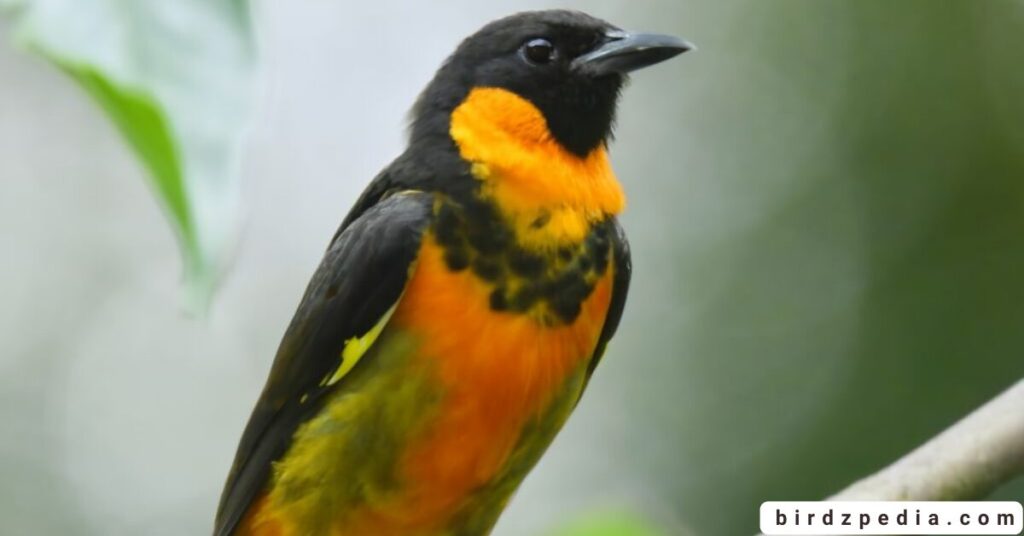
18 Ruddy Shelduck
The Anatidae family includes the ruddy shelduck (Tadorna ferruginea), also referred to as the Brahminy duck in India. At 58 to 70 cm (23 to 28 in) in length and 110 to 135 cm (43 to 53 in) in wingspan, it is a unique waterfowl. Its head is paler than its orange-brown body plumage, and its black tail and flying feathers in its wings contrast sharply with its white wing-coverts.
| Attribute | Information |
|---|---|
| Scientific Name | Tadorna ferruginea |
| Common Name | Ruddy Shelduck |
| Plumage | Mostly orange or orange-brown, white face masks, black tails. |
| Habitat | Water and adjacent areas like lakes, reservoirs, canals. Nesting males and females found further from water. |
| Distribution | Mostly common in Asia, extinct from Europe, surviving in remote parts of Northern Africa. |
| Behavior | Males and females often seen together, may stay together after breeding. Nocturnal, come out for food at night. |
| Breeding Season | Breeding season may see them in lakes and ponds, not easy to spot. |
| Distribution Area | Russia, China, India, Morocco. |

19 Allen’s Hummingbird
One species of hummingbird is the Allen’s hummingbird (Selasphorus sasin). It belongs to the genus Selasphorus, which has seven species.Mature adults of the Allen’s hummingbird grow to be only 3 to 3.5 in (76 to 89 mm) in length and weigh between 2 and 4 grams.
| Attribute | Information |
|---|---|
| Scientific Name | Selasphorus sasin |
| Common Name | Allen’s Hummingbird |
| Description (Male) | Orange belly and head, white upper chest, dark brown neck band, black and metallic green wings, long black beak. Irregular flight patterns. |
| Habitat | Native to North and Central America, coastal areas in Southwestern US territories. |
| Behavior | High aggressiveness, males chase off other males during breeding. |
| Breeding Range | Coastal areas in Southwestern US (California, Oregon). |
| Migration | Migratory, move South to overwinter; some populations in Southwestern California stay year-round. |
| Diet | Drinks nectar from flowers, eats insects feeding on pollen or nectar. |
| Distribution Area | Oregon, California, Central America. |

20 Rufous Hummingbird
The rufous hummingbird, or Selasphorus rufus, is a little hummingbird with a long, straight bill that measures approximately 8 cm (3.1 in) in length. Known for their exceptional flying abilities, these birds can travel 2,000 miles (3,200 km) as part of their migratory transits. It belongs to the genus Selasphorus, which has nine species.
| Attribute | Information |
|---|---|
| Scientific Name | Selasphorus rufus |
| Common Name | Rufous Hummingbird |
| Description | Small orange areas on bellies, red-brown heads, multicolored, long tongues and beaks. |
| Behavior | Hover next to plants for nectar, engage in long-distance migration. |
| Migration | Fly thousands of miles from Northwestern Canadian territories to The Gulf of Mexico. |
| Habitat | Next to woodlands or in clearings along woodlands. |
| Distribution Area | Alaska, Northeastern Canada, United States, Mexico. |

21 Blue-Fronted Redstart
The bird species known as the blue-fronted redstart (Phoenicurus frontalis) belongs to the Old World flycatcher family, Muscicapidae.The temperate woodlands are its natural habitat. The female has paler underparts and is brownish-grey in color.
| Attribute | Information |
|---|---|
| Scientific Name | Phoenicurus frontalis |
| Common Name | Blue-fronted Redstart |
| Description (Male) | Bright orange belly, blue head and wings. |
| Description (Female) | Orange spots on wings, yellow belly, gray head. |
| Habitat | Temperate woodlands of Asia. |
| Breeding Sound | Produces tick-tick sound during breeding season. |
| Distribution Area | Northern India, Myanmar, Thailand, China. |
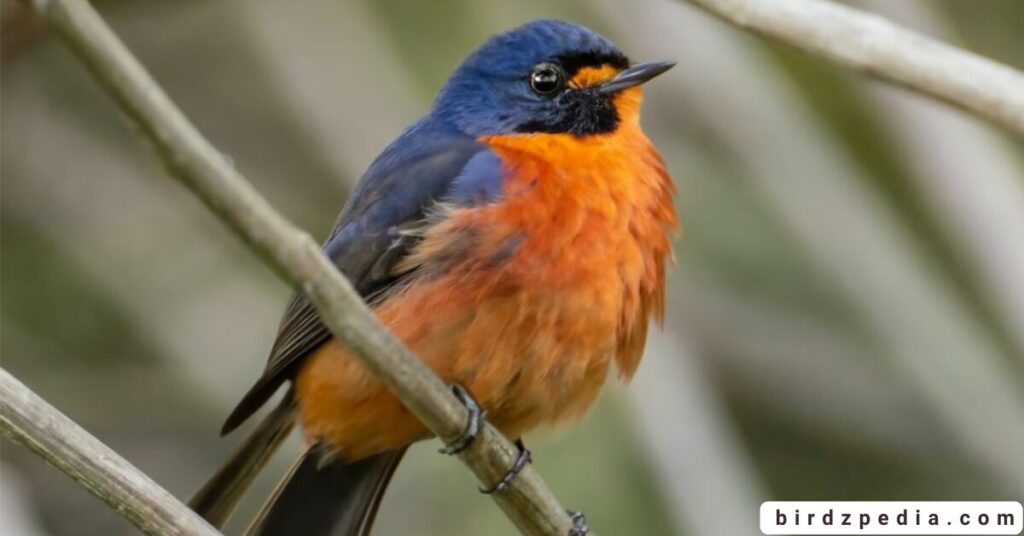
22 Gartered Trogon
Within the family Trogonidae, which also includes quetzals and trogons, is the gartered trogon (Trogon caligatus), commonly referred to as the northern violaceous trogon.The majority of trogons have unique plumage, with soft, frequently colorful feathers on the male and female. The gartered trogon weighs 38–57 g (1.3–2.0 oz) and measures 23–25 cm (9.1–9.8 in) in length.
| Attribute | Information |
|---|---|
| Scientific Name | Trogon caligatus |
| Common Name | Gartered Trogon |
| Description (Male) | Yellow-orange belly, black head, blue chest. |
| Description (Female) | Brighter orange to yellow belly, gray head. |
| Habitat | Central and South America, often seen foraging with other species. |
| Size | Nearly 10 inches |
| Distribution Area | Mexico, Panama, Guatemala, Colombia, Ecuador, Peru. |

23 Elegant Euphonia
Within the family Fringillidae is the elegant or blue-hooded euphonia (Chlorophonia elegantissima). It was traditionally placed in the Euphonia genus, but phylogenetic analysis places it in the Chlorophonia group. Its natural habitats are badly degraded former forests and subtropical or tropical moist montane forests.
| Attribute | Information |
|---|---|
| Scientific Name | Chlorophonia elegantissima |
| Common Name | Elegant Euphonia |
| Description (Male) | Bright orange belly, blue head with black mask, metallic dark blue or violet wings. |
| Description (Female) | Lime-yellow belly, light blue head and wings, small orange spot on face. |
| Habitat | Pineoak woodlands in Central America. |
| Grouping | Seen in small groups across Central American countries. |
| Distribution Area | Mexico, Guatemala, Nicaragua, Costa Rica, Panama. |

24 Black-Backed Oriole
One species of bird in the Icteridae family is the black-backed oriole (Icterus abeillei). Because it has developed a tolerance to the inherent venom of monarch butterflies, it is one of the few animals that can eat them.
| Attribute | Information |
|---|---|
| Scientific Name | Icterus abeillei |
| Common Name | Black-backed Oriole |
| Description (Male) | Vivid orange belly, black head, back, and wings, with two small orange spots above the eyes. |
| Description (Female/Juveniles) | Lighter, dominated by yellow, green, and bright gray colors. |
| Habitat | Crops, farmland, open woodlands. |
| Distribution Area | Mexico |

25 Flame Robin
Australia is home to the little passerine bird known as the flaming robin (Petroica phoenicea).The flame robin is a small, thin black bird with dark brown eyes that is 12–14 cm (4.7–5.5 in) in length. Compared to other members of the genus Petroica, it is more slenderly built, with a small head, moderately long neck, and wings.
| Attribute | Information |
|---|---|
| Scientific Name | Petroica phoenicea |
| Common Name | Flame Robin |
| Description (Male) | Vivid dark orange bellies, dark gray and black contrasting wings, gray and white heads. |
| Description (Female/Juveniles) | Mostly dark brown or gray, with yellow or gray bellies. |
| Habitat | Open areas such as parks and gardens. |
| Native Range | Southeast Australia, including areas in Melbourne. |
| Distribution Area | Southeast Australia, Tasmania. |

26 Azure Kingfisher
Within the Alcedininae subfamily of river kingfishers is the little blue kingfisher, Ceyx azureus.The male azure kingfisher weighs 29–32 g (1.0–1.1 oz), while the female weighs 31–35 g (1.1–1.2 oz). The azure kingfisher is 17–19 cm (6.7–7.5 in) long.
| Attribute | Information |
|---|---|
| Scientific Name | Ceyx azureus |
| Common Name | Azure Kingfisher |
| Description | Orange bellies in different shades, lighter orange section on inner belly and upper chest, blue head and wings, long black beak, dark orange legs. |
| Behavior | Not known for singing, make noises during breeding. Feed on shrimp and crustaceans. |
| Habitat | Water bodies in Australia. |
| Distribution Area | Australia |

27 Red-Breasted Nuthatch
A little songbird, the red-breasted nuthatch (Sitta canadensis) is small. The adult features a black head, a straight grey bill, a white throat, and cinnamon underparts with blue-grey upperparts and a black stripe through the eyes.The red-breasted nuthatch is a small passerine that weighs 9.9 g (0.35 oz) and is 4.5 in (11 cm) long with a wingspan of 8.5 in (22 cm).
| Attribute | Information |
|---|---|
| Scientific Name | Sitta canadensis |
| Common Name | Red-breasted Nuthatch |
| Description | Yellow-to-orange belly, found throughout Southern Canadian states and the US (except Southern Florida and including Alaska). |
| Habitat | Found in some of the highest-elevation woodlands, common up to subalpine regions. May mix with other species and share trees with woodpeckers. |
| Diet | Feeds on insects and various seeds. |
| Vocalization | Recognizable by their “yee-eenk” singing. |
| Distribution Area | Canada, the United States. |

28 Varied Thrush
A member of the Turdidae thrush family is the variegated thrush (Ixoreus naevius). Within the monotypic genus Ixoreus, it is the sole species. One rather large species of thrush is the variegated thrush. Its length varies from 20 to 26 cm (7.9 to 10.2 in) and its width across the wings is 34 to 42 cm (13 to 17 in).
Body mass can range from 2.3 to 3.5 ounces (65 to 100 g). The conventional measurements are as follows: the tarsus measures 2.9 to 3.3 cm (1.1 to 1.3 in), the bill measures 1.8 to 2.3 cm (0.71 to 0.91 in), and the wing chord measures 11.8 to 13.6 cm (4.6 to 5.4 in).
| Attribute | Information |
|---|---|
| Scientific Name | Ixoreus naevius |
| Common Name | Varied Thrush |
| Description | Bright orange bellies and necks, brown heads, black beaks. Brown and orange wings. Males generally show richer colors in orange sections. |
| Habitat | Coniferous woodlands mainly west of the Rocky Mountains Range. |
| Diet | Feeds on insects and small fruits of wildflowers. |
| Distribution Area | Canada (Yukon, Northern Territories, British Columbia), US (Alaska, Washington, Oregon, California). |
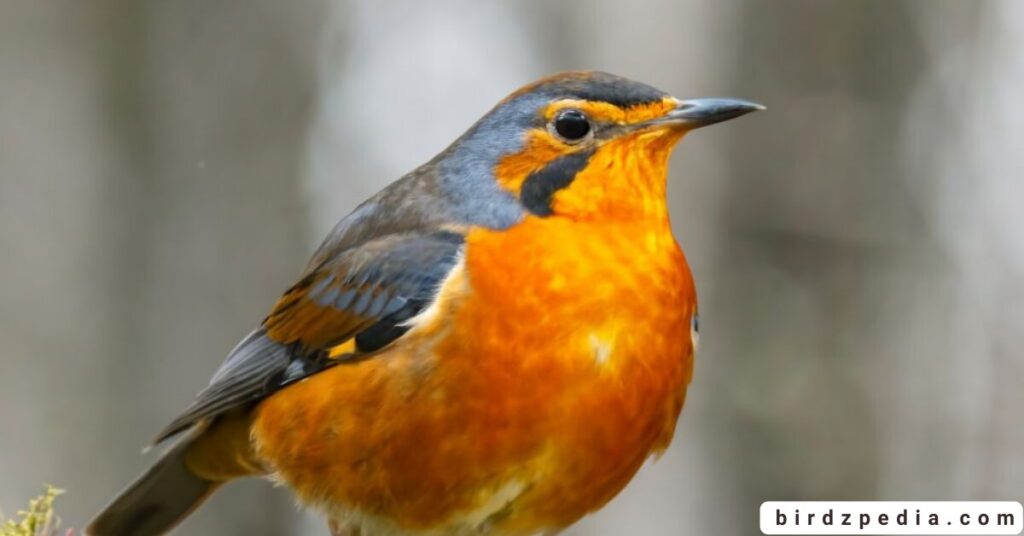
29 Say’s Phoebe
Sayornis saya, often known as Say’s phoebe, is a passerine bird belonging to the Tyrannidae family of flycatchers. The American naturalist Thomas Say inspired the name Thomas Say.The mature bird weighs 0.75 oz (21 g), measures 7.5 in (19 cm) length, and has a wingspan of 13 in (33 cm).
| Attribute | Information |
|---|---|
| Scientific Name | Sayornis saya |
| Common Name | Say’s Phoebe |
| Description | Birds with orange bellies, orange patch on lower bellies, white or gray upper chest, gray or gray and yellow heads, short black beaks. Female wings lighter than male’s. |
| Habitat | Common sight on farms and crops. |
| Diet | Eats small bugs, insects, and their larvae. |
| Distribution Area | Canada, United States, Mexico. |
| Migration | Strongly migratory, expands range to Northern limits of North America; populations in British Columbia and Alaska move Southwards to Central America to overwinter. |

30 Western Bluebird
Small North American thrush, Sialia mexicana, is known as the western bluebird. The western bluebird is a tiny, stocky bird that ranges in length from 5.9 to 7.1 inches, or 15 to 18 cm. Their mating calls are made comprised of the sounds “cheer,” “chur-chur,” and “chup.”
| Attribute | Information |
|---|---|
| Common Name | Western Bluebird |
| Description (Male) | Blue heads and backs, rusted orange vest. |
| Description (Female) | Less intensely colored, wash of orange on chests. |
| Nesting Habits | Readily nest in birdhouses of suitable dimensions. |
| Diet | Mostly insectivores, will visit feeders with mealworms. |
| Distribution Area | Throughout western U.S., variable populations of year-round, breeding, migrating, and wintering residents. |
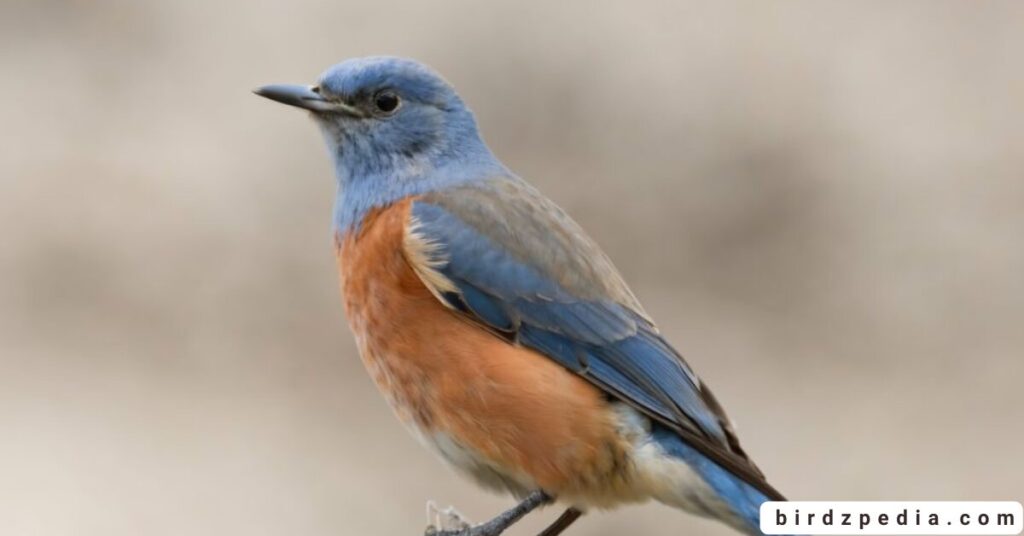
31 Eastern Bluebird
Found in open forests, farmlands, and orchards, the eastern bluebird (Sialia sialis) is a little migratory thrush native to North America.The length of the eastern bluebird is 16–21 cm (6.3–8.3 in), its wingspan is 25–32 cm (9.8–12.6 in), and its weight is 27–34 g (0.95–1.20 oz).
| Attribute | Information |
|---|---|
| Scientific Name | Sialia sialis |
| Description (Male) | Striking coloring: blue above, rusty orange on top half of breast, white on bottom half. |
| Description (Female) | Less vibrant, more grey overall, orange wash on chest. |
| Habitat and Range | Year-round presence in eastern half of U.S., breed in northern states and Canada, winter on outskirts of Texas, New Mexico, and Colorado. |

32 American Woodcock
The timberdoodle, also known as the American woodcock (Scolopax minor), is a small species of shorebird. Adults weigh 5 to 8 ounces (140 to 230 g) and measure 10 to 12 inches (25 to 30 cm) in length. Compared to males, females are significantly larger. The length of the bill is 6.4 to 7.1 cm,
or 2.5 to 2.8 inches. The range of wingspans is 16.5 to 18.9 inches (42 to 48 cm).Woodcocks are thought to have the greatest visual field of any bird, measuring 360° in the horizontal plane and 180° in the vertical plane. Their enormous eyes are situated high in their heads.
| Attribute | Information |
|---|---|
| Scientific Name | Scolopax minor |
| Description | Chunky birds with large heads, absence of neck, giving them a bulging shape. Excellent camouflage with black and brown mottled coloring and grey stripes on back. Light tawny to orange breasts and bellies. |
| Behavior | Probes the ground for food. Able to keep eyes out for predators while feeding due to eyes’ positioning high on skull and closer to back of head. |
| Habitat and Range | Found throughout eastern North America. |

33 Blackburnian warbler
One of the smaller warblers of the New World is the Blackburnian (Setophaga fusca).They weigh 8 to 13 g (0.28 to 0.46 oz), and measure approximately 11 to 13 cm (4.3 to 5.1 in) in length and 20 to 22 cm (7.9 to 8.7 in) in wingspan. An adult bird’s mass averages 9.7 g (0.34 oz), but in the fall, because of its fat
reserves, it can reach an average of 10.2–10.4 g (0.36–0.37 oz). The wing chord measures 6.3 to 7.3 cm (2.5 to 2.9 in), the tail measures 4.2 to 5 cm (1.7 to 2.0 in), the beak measures 0.9 to 1 cm (0.35 to 0.39 in), and the tarsus measures 1.6 to 1.8 cm (0.63 to 0.71 in). These are the standard measurements.
| Attribute | Information |
|---|---|
| Common Name | Warblers |
| Breeding Males | Black and white on top, striking orange plumage on face and throat, wash on belly. |
| Breeding Range | Northern states of eastern U.S. and into Canada. |
| Migration | Use eastern U.S. as migration states. |
| Behavior | Do a lot of flying each year, often find themselves off course between North and South America. |
| Vagrants | Found in Iceland, Greenland, Scotland, and the Azores off western Africa. |

34 American Goldfinch
Small and belonging to the finch family, the American goldfinch (Spinus tristis) is found throughout North America. The American goldfinch has a wingspan of 19–22 cm (7.5–8.7 in) and measures 11–14 cm (4.3–5.5 in) in length. It weights 0.39 to 0.71 ounces, or 11 to 20 grams.
The wing chord measures 6.5 to 7.8 cm (2.6 to 3.1 in), the tail measures 4.2 to 5.1 cm (1.7 to 2.0 in), the culmen measures 0.9 to 1.1 cm (0.35 to 0.43 in), and the tarsus measures 1.2 to 1.4 cm (0.47 to 0.55 in). These are the standard measurements.
| Attribute | Information |
|---|---|
| Scientific Name | Spinus tristis |
| Description (Male) | Orange belly contrasting with black wings. |
| Description (Female) | Gray-brown belly, no orange color on wings. |
| Habitat | Much of North America, including Canada, parts of Mexico, Alaska, most of Hawaii, and some coastal regions along the Gulf of Mexico. |
| Feeding Habits | Diurnal feeder, eats thistle seeds and sunflower seeds. |
| Behavior | Often found flitting around in large groups. |

35 Spotted Towhee
Large New World sparrows like the spotted towhee (Pipilo maculatus) are common.The spotted towhee weighs between 33 g (1.2 oz) and 49 g (1.7 oz) and measures between 17 cm (6.7 in) and 21 cm (8.3 in) in length. Its wingspan measures 11.0 inches (28 cm).
| Attribute | Information |
|---|---|
| Scientific Name | Pipilo maculatus |
| Description | Bird with orange bellies, white underparts, rust color spots on wings. |
| Habitat | Western parts of the United States, southern Canada. |
| Foraging Habits | Forages on ground or in low vegetation, noisily rummaging through dry leaves for food. |
| Nesting Habits | Nests on ground or low in bushes, seldom more than 1.5 m (4.9 ft) above ground. |
| Vocalization | Sings loudly with a sound similar to a cat’s meow. |

36 American Kestrel
The smallest and most prevalent falcon in North America is the American kestrel (Falco sparverius), sometimes known as the sparrow hawk. The bird has a wingspan of 51–61 cm (20–24 in) and measures between 22 and 31 cm (8.7 and 12.2 in) in length. Within a subspecies, the female kestrel is usually 10% to 15% larger than the male, though not as much as larger falcons.
| Attribute | Information |
|---|---|
| Scientific Name | Falco sparverius |
| Description | Soft orange belly, blue-gray wings. |
| Size | Reaches no more than 14 inches in height. |
| Diet | primarily eats small creatures, including frogs, mice, voles, shrews, grasshoppers, crickets, butterflies, moths, dragonflies, beetles, and small birds. |
| Habitat and Range | Found throughout over the United States and southern half of Canada, with the exception of areas of Georgia, Texas, western Oregon, Washington state west of the Cascade Mountains, and California south of the Sierra Nevada range. |
| Vocalizations | The “klee” or “killy”, the “whine”, and the “chitter” are the three fundamental vocalizations. When the kestrel is unhappy or enthusiastic, the “klee” is typically given in a quick series: klee, klee, klee, klee. |

FAQs
- What Types of Birds are Orange Belly Birds ?
- In the United States, there are numerous orange-breasted bird species with orange bellies. But typically, these vivid hues don’t show up until after they are two or three years old. Several species of hummingbirds, orioles, cardinals, and blackbirds are among the most commonly observed orange-bellied birds.
- What are the most common birds that have an orange chest?
- American Robins are the most prevalent birds with an orange chest in North America. European Robins, on the other hand, are the most prevalent orange-chested birds in Europe.
- In metropolitan locations in the United States and Canada, American Robins are a frequent breeding bird. They also visit bird feeders that provide mealworms, berries, and apples.
When the breeding season is over, they like to group together into large flocks and sleep on trees.
- How can you attract these birds to your yard?
- The following are the top 5 things you can do to get these birds to visit your yard:
- Place berries, fruits, and seeds in a feeder.
- Install a bird bath.
- Plant shrubs to create places for nesting
- Plant fruit trees that are indigenous.
- If you want to draw orioles in particular, set up a nectar feeder or some grape jelly.
- What birds are blue with an orange chest?
- Eastern Bluebird
- Western Bluebird
- What small birds have an orange chest?
- Red-breasted Nuthatch
- Allen’s Hummingbird
- Rufous Hummingbird
- What orange belly birds have a black head?
- American Robin
- Baltimore Oriole
- Orchard Oriole
- Black-headed Grosbeak
- Varied Thrush


![Choco Toucan[Ramphastos brevis] Tales and Overview](https://birdzpedia.com/wp-content/uploads/2024/01/Ramphastos-brevis-768x402.jpg)
![Little pied cormorant[Microcarbo melanoleucos]: Fascinating Details](https://birdzpedia.com/wp-content/uploads/2024/01/Little-pied-cormorant-768x402.jpg)
![Black Stork [Ciconia nigra] Haven: Wings, Nature, and Conservation](https://birdzpedia.com/wp-content/uploads/2023/12/African-Openbill-7-768x402.png)
![Northern bald ibis: [Geronticus eremita] Discovering Nature’s Secrets](https://birdzpedia.com/wp-content/uploads/2024/01/Northern-Frigatebird-768x402.png)

![Fish Crow [Corvus ossifragus] Facts, Sounds, Habitat](https://birdzpedia.com/wp-content/uploads/2023/12/Fish-Crow-768x402.png)